Natural Rubber Latex-Modified Concrete with PET and Crumb Rubber Aggregate Replacements for Sustainable Rigid Pavements
Abstract
:1. Introduction
2. Materials and Methods
2.1. Materials
2.2. Concrete Mix Design
2.3. Experimental Testing Program
2.3.1. Compressive and Flexural Strengths
2.3.2. Scanning Electron Microscopy (SEM)
3. Results and Discussion
3.1. Compressive Strength
3.2. Flexural Strength
3.3. Microstructural Analysis
4. Conclusions
Author Contributions
Funding
Institutional Review Board Statement
Informed Consent Statement
Data Availability Statement
Acknowledgments
Conflicts of Interest
Abbreviations
| C-S-H | Calcium silicate hydrate |
| CR | crumb rubber |
| fc | compressive strength |
| ff | flexural strength |
| NRL | Natural rubber latex |
| PET | Polyethylene terephthalate |
| r/c | rubber-to-cement ratio |
| SBR | Styrene-butadiene rubber |
| SEM | Scanning electron microscopy |
| WNRL | Water content in natural rubber latex |
References
- Ng, C.P.; Law, T.H.; Jakarni, F.M.; Kulanthayan, S. Road infrastructure development and economic growth. In IOP Conference Series: Materials Science and Engineering; IOP Publishing: Bristol, UK, 2019. [Google Scholar]
- Weizheng, Y. Research about the impact of transportation infrastructure on economic growth in a transportation power. E3S Web Conf. 2021, 253, 01037. [Google Scholar] [CrossRef]
- Yu, N.; De Jong, M.; Storm, S.; Mi, J. The growth impact of transport infrastructure investment: A regional analysis for China (1978–2008). Policy Soc. 2012, 31, 25–38. [Google Scholar] [CrossRef]
- Zhang, M.; Li, Z.; Wang, X.; Li, J.; Liu, H.; Zhang, Y. The Mechanisms of the Transportation Land Transfer Impact on Economic Growth: Evidence from China. Land 2021, 11, 30. [Google Scholar] [CrossRef]
- Hrapović, K. Paving of concrete carriageway Case study Tauern motorway at the Wengen-Pongau junction. J. Road Traffic Eng. 2023, 69, 1–12. [Google Scholar] [CrossRef]
- Nosov, V.P.; Ushakov, V.V.; Fotiadi, A.A.; Stepush, A.P. Improving the regulatory framework for the design of rigid pavements. In IOP Conference Series: Materials Science and Engineering; IOP Publishing: Bristol, UK, 2020. [Google Scholar] [CrossRef]
- Peng, X. Recycling technology of old cement concrete pavement in highways. Vibroengineering Procedia 2022, 46, 86–91. [Google Scholar] [CrossRef]
- Ma, F.; Sha, A.; Yang, P.; Huang, Y. The Greenhouse Gas Emission from Portland Cement Concrete Pavement Construction in China. Int. J. Environ. Res. Public Health 2016, 13, 632. [Google Scholar] [CrossRef]
- García-Segura, T.; Yepes, V.; Alcalá, J. Life cycle greenhouse gas emissions of blended cement concrete including carbonation and durability. Int. J. Life Cycle Assess. 2014, 19, 3–12. [Google Scholar] [CrossRef]
- Deja, J.; Uliasz-Bochenczyk, A.; Mokrzycki, E. CO2 emissions from Polish cement industry. Int. J. Greenh. Gas Control 2010, 4, 583–588. [Google Scholar] [CrossRef]
- Pheeraphan, T. Comparative study of properties of concrete made of hydraulic cement (TIS 2594) and ordinary Portland cement (TIS 15). J. Thail. Concr. Assoc. 2021, 9, 1–6. [Google Scholar]
- Prakash, R.; Thenmozhi, R.; Raman, S.N.; Subramanian, C. Characterization of eco-friendly steel fiber-reinforced concrete containing waste coconut shell as coarse aggregates and fly ash as partial cement replacement. Struct. Concr. 2020, 21, 437–447. [Google Scholar] [CrossRef]
- Prakash, R.; Divyah, N.; Srividhya, S.; Avudaiappan, S.; Amran, M.; Raman, S.N.; Guindos, P.; Vatin, N.I.; Fediuk, R. Effect of Steel Fiber on the Strength and Flexural Characteristics of Coconut Shell Concrete Partially Blended with Fly Ash. Materials 2022, 15, 4272. [Google Scholar] [CrossRef] [PubMed]
- Prakash, R.; Thenmozhi, R.; Raman, S.N.; Subramanian, C.; Divyah, N. Mechanical characterisation of sustainable fibre-reinforced lightweight concrete incorporating waste coconut shell as coarse aggregate and sisal fibre. Int. J. Environ. Sci. Technol. 2021, 18, 1579–1590. [Google Scholar] [CrossRef]
- Adrados, A.; de Marco, I.; Caballero, B.; López, A.; Laresgoiti, M.; Torres, A. Pyrolysis of plastic packaging waste: A comparison of plastic residuals from material recovery facilities with simulated plastic waste. Waste Manag. 2012, 32, 826–832. [Google Scholar] [CrossRef]
- Duncan, E.M.; Arrowsmith, J.; Bain, C.; Broderick, A.C.; Lee, J.; Metcalfe, K.; Pikesley, S.K.; Snape, R.T.; van Sebille, E.; Godley, B.J. The true depth of the Mediterranean plastic problem: Extreme microplastic pollution on marine turtle nesting beaches in Cyprus. Mar. Pollut. Bull. 2018, 136, 334–340. [Google Scholar] [CrossRef] [PubMed]
- Crawford, C.B.; Quinn, B. Microplastic Pollutants; Elsevier: Amsterdam, The Netherlands, 2016. [Google Scholar]
- Barbooti, M.M.; Mohamed, T.J.; Hussain, A.A.; Abas, F.O. Optimization of pyrolysis conditions of scrap tires under inert gas atmosphere. J. Anal. Appl. Pyrolysis 2004, 72, 165–170. [Google Scholar] [CrossRef]
- Fernández, A.M.; Díez, M.A.; Alvarez, R.; Barriocanal, C. Pyrolysis of tyre wastes. In Proceedings of the 1st Spanish National Conference on Advances in Materials Recycling and Eco–Energy, Madrid, Spain, 12–13 November 2009. [Google Scholar]
- López, F.A.; Centeno, T.A.; Alguacil, F.J.; Lobato, B.; López-Delgado, A.; Fermoso, J. Gasification of the char derived from distillation of granulated scrap tyres. Waste Manag. 2012, 32, 743–752. [Google Scholar] [CrossRef]
- Islam, M.R.; Parveen, M.; Haniu, H.; Sarker, M.I. Innovation in pyrolysis technology for management of scrap tire: A solution of energy and environment. Int. J. Environ. Sci. Dev. 2010, 1, 89. [Google Scholar] [CrossRef]
- Kuncser, R.; Paraschiv, M.; Tazerout, M.; Bellettre, J. Liquid fuel recovery through pyrolysis of polyethylene waste. Environ. Eng. Manag. J. 2010, 9, 1371–1374. [Google Scholar] [CrossRef]
- Wójtowicz, M.A.; Serio, M.A. Pyrolysis of scrap tires: Can it be profitable? Chemtech 1996, 26, 48–53. [Google Scholar]
- Saikia, N.; de Brito, J. Use of plastic waste as aggregate in cement mortar and concrete preparation: A review. Constr. Build. Mater. 2012, 34, 385–401. [Google Scholar] [CrossRef]
- Youssf, O.; Mills, J.E.; Hassanli, R. Assessment of the mechanical performance of crumb rubber concrete. Constr. Build. Mater. 2016, 125, 175–183. [Google Scholar] [CrossRef]
- Park, Y.; Abolmaali, A.; Kim, Y.H.; Ghahremannejad, M. Compressive strength of fly ash-based geopolymer concrete with crumb rubber partially replacing sand. Constr. Build. Mater. 2016, 118, 43–51. [Google Scholar] [CrossRef]
- Islam, M.J.; Meherier, M.S.; Islam, A.R. Effects of waste PET as coarse aggregate on the fresh and harden properties of concrete. Constr. Build. Mater. 2016, 125, 946–951. [Google Scholar] [CrossRef]
- Sundaresan, S.; Ramamurthy, V.; Meyappan, N. Improving mechanical and durability properties of hypo sludge concrete with basalt fibres and SBR latex. Adv. Concr. Constr. 2021, 12, 327. [Google Scholar]
- Srividhya, S.; Vidjeapriya, R.; Neelamegam, M. Enhancing the performance of hyposludge concrete beams using basalt fiber and latex under cyclic loading. Comput. Concr. 2021, 28, 93. [Google Scholar]
- Yaowarat, T.; Suddeepong, A.; Hoy, M.; Horpibulsuk, S.; Takaikaew, T.; Vichitcholchai, N.; Arulrajah, A.; Chinkulkijniwat, A. Improvement of flexural strength of concrete pavements using natural rubber latex. Constr. Build. Mater. 2021, 282, 122704. [Google Scholar] [CrossRef]
- ASTM C128-01; ASTM, Standard Test Method for Density, Relative Density (Specific Gravity), and Absorption of Fine Aggregate. ASTM International: West Conshohocken, PA, USA, 2001.
- ASTM C127-01; ASTM, Standard Test Method for Density, Relative Density (Specific Gravity), and Absorption of Coarse Aggregate. ASTM International: West Conshohocken, PA, USA, 2001.
- Al-Manaseer, A.A.; Dalal, T.R. Concrete containing plastic aggregates. Concr. Int. 1997, 19, 47–52. [Google Scholar]
- ASTM C136-01; ASTM, Standard Test Method for Sieve Analysis of Fine and Coarse Aggregates. ASTM International: West Conshohocken, PA, USA, 2001.
- ASTM C33; ASTM, Standard Specification for Concrete Aggregates. ASTM International: West Conshohocken, PA, USA, 2016.
- Suddeepong, A.; Buritatum, A.; Hoy, M.; Horpibulsuk, S.; Takaikaew, T.; Horpibulsuk, J.; Arulrajah, A. Natural Rubber Latex–Modified Concrete Pavements: Evaluation and Design Approach. J. Mater. Civ. Eng. 2022, 34, 04022215. [Google Scholar] [CrossRef]
- ASTM C192; ASTM, Standard Practice for Making and Curing Concrete Test Specimens in the Laboratory. ASTM International: West Conshohocken, PA, USA, 2016.
- ASTM C39; ASTM, Standard Test Method for Compressive Strength of Cylindrical Concrete Specimens. ASTM International: West Conshohocken, PA, USA, 2016.
- AASHTO T97; AASHTO, Standard Method of Test for Flexural Strength of Concrete (Using Simple Beam with Third-Point Loading). American Association of State Highway and Transportation Officials: Washington, DC, USA, 2002.
- DH-S309/2544; DOH, Standards for Highway Construction. Thailand Department of Highways: Bangkok, Thailand, 1996.
- Umasabor, R.; Daniel, S. The effect of using polyethylene terephthalate as an additive on the flexural and compressive strength of concrete. Heliyon 2020, 6, e04700. [Google Scholar] [CrossRef]
- Chong, B.W.; Shi, X. Meta-analysis on PET plastic as concrete aggregate using response surface methodology and regression analysis. J. Infrastruct. Preserv. Resil. 2023, 4, 2. [Google Scholar] [CrossRef]
- Frigione, M. Recycling of PET bottles as fine aggregate in concrete. Waste Manag. 2010, 30, 1101–1106. [Google Scholar] [CrossRef] [PubMed]
- Guo, S.; Dai, Q.; Si, R.; Sun, X.; Lu, C. Evaluation of properties and performance of rubber-modified concrete for recycling of waste scrap tire. J. Clean. Prod. 2017, 148, 681–689. [Google Scholar] [CrossRef]
- Lohaus, L.; Anders, S. Ductility and Fatigue Behaviour of Polymer-Modified and Fibre-Reinforced High-Performance Concrete. In Advances in Construction Materials; Springer: Berlin/Heidelberg, Germany, 2007; pp. 165–172. [Google Scholar] [CrossRef]
- Wille, K.; El-Tawil, S.; Naaman, A. Properties of strain hardening ultra high performance fiber reinforced concrete (UHP-FRC) under direct tensile loading. Cem. Concr. Compos. 2014, 48, 53–66. [Google Scholar] [CrossRef]
- Zhu, W.; Yang, C.; Yu, Z.; Xiao, J.; Xu, Y. Impact of Defects in Steel-Concrete Interface on the Corrosion-Induced Cracking Propagation of the Reinforced Concrete. KSCE J. Civ. Eng. 2023, 27, 2621–2628. [Google Scholar] [CrossRef]
- Zhu, W.; Yu, Z.; Yang, C.; Dong, F.; Ren, Z.; Zhang, K. Spatial Distribution of Corrosion Products Influenced by the Initial Defects and Corrosion-Induced Cracking of the Concrete. J. Test. Eval. 2023, 51, 2582–2597. [Google Scholar] [CrossRef]

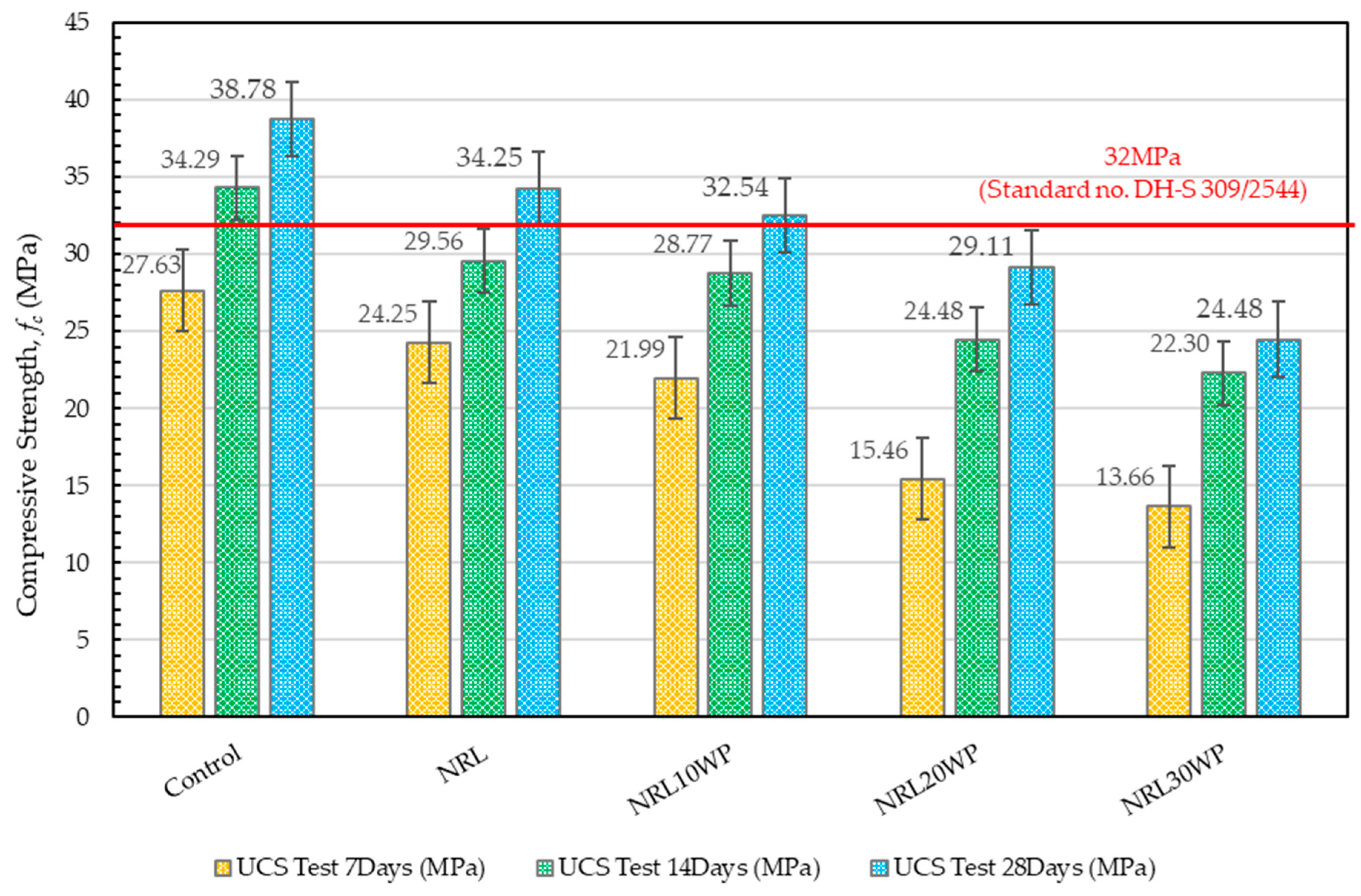
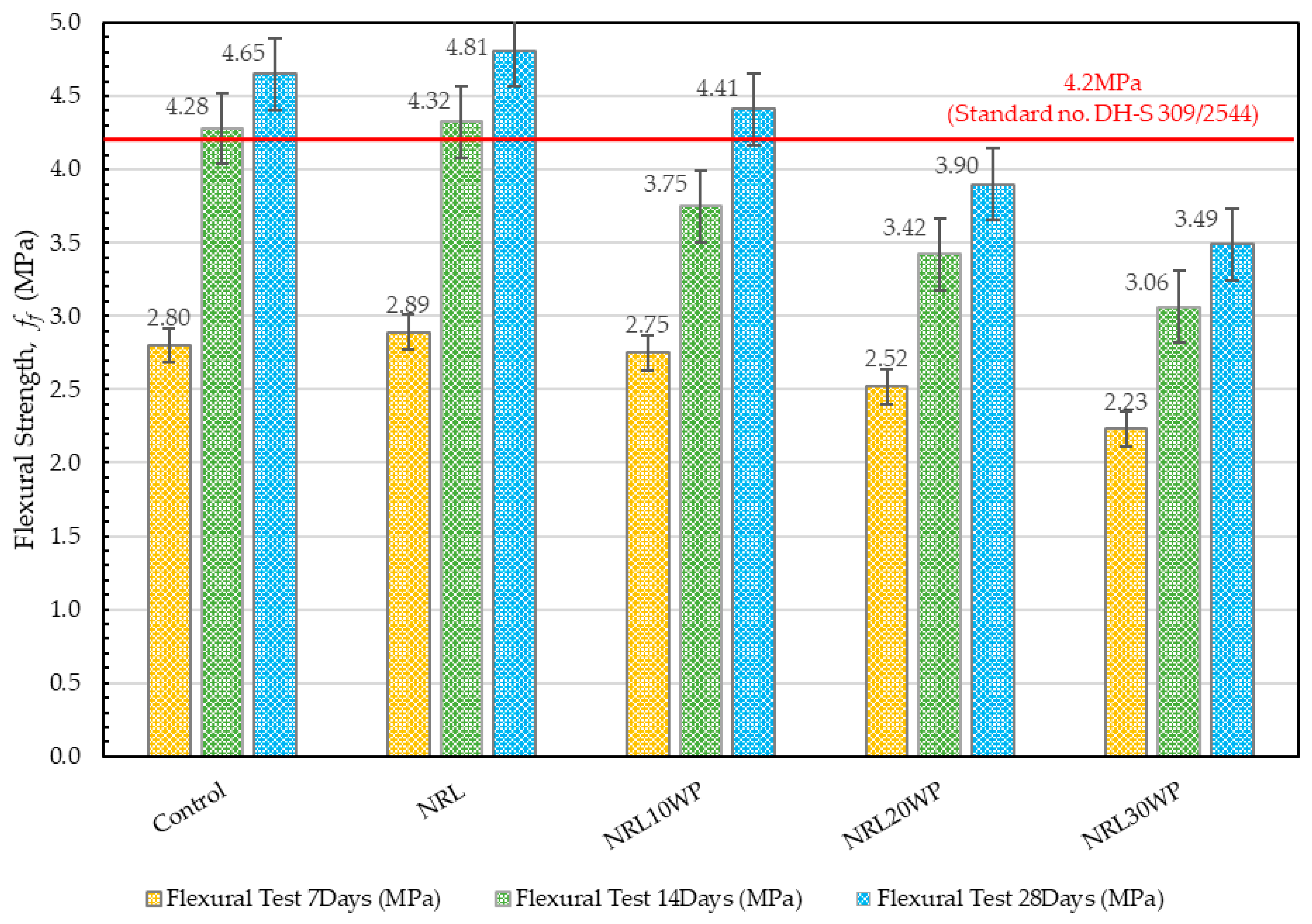

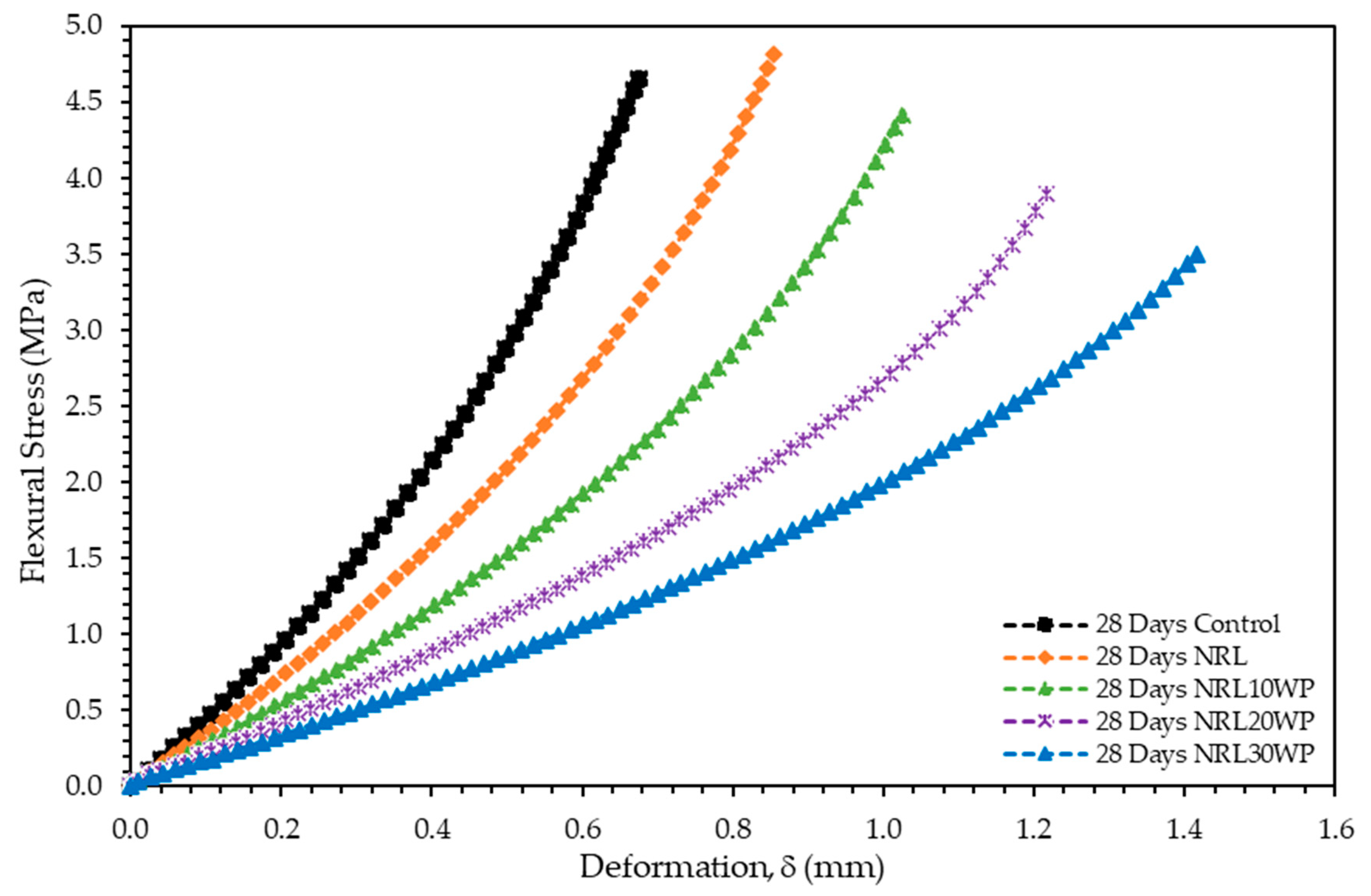

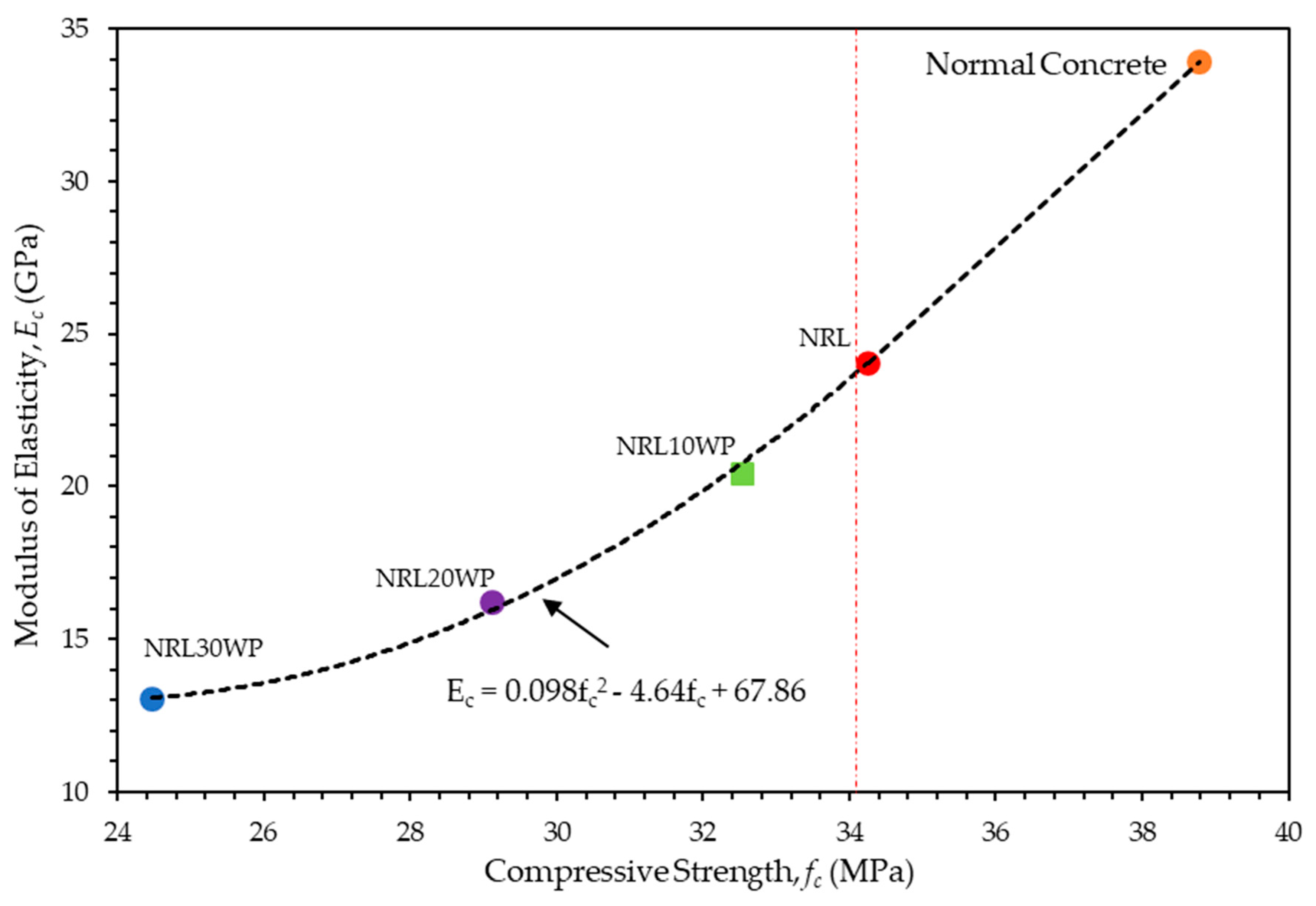
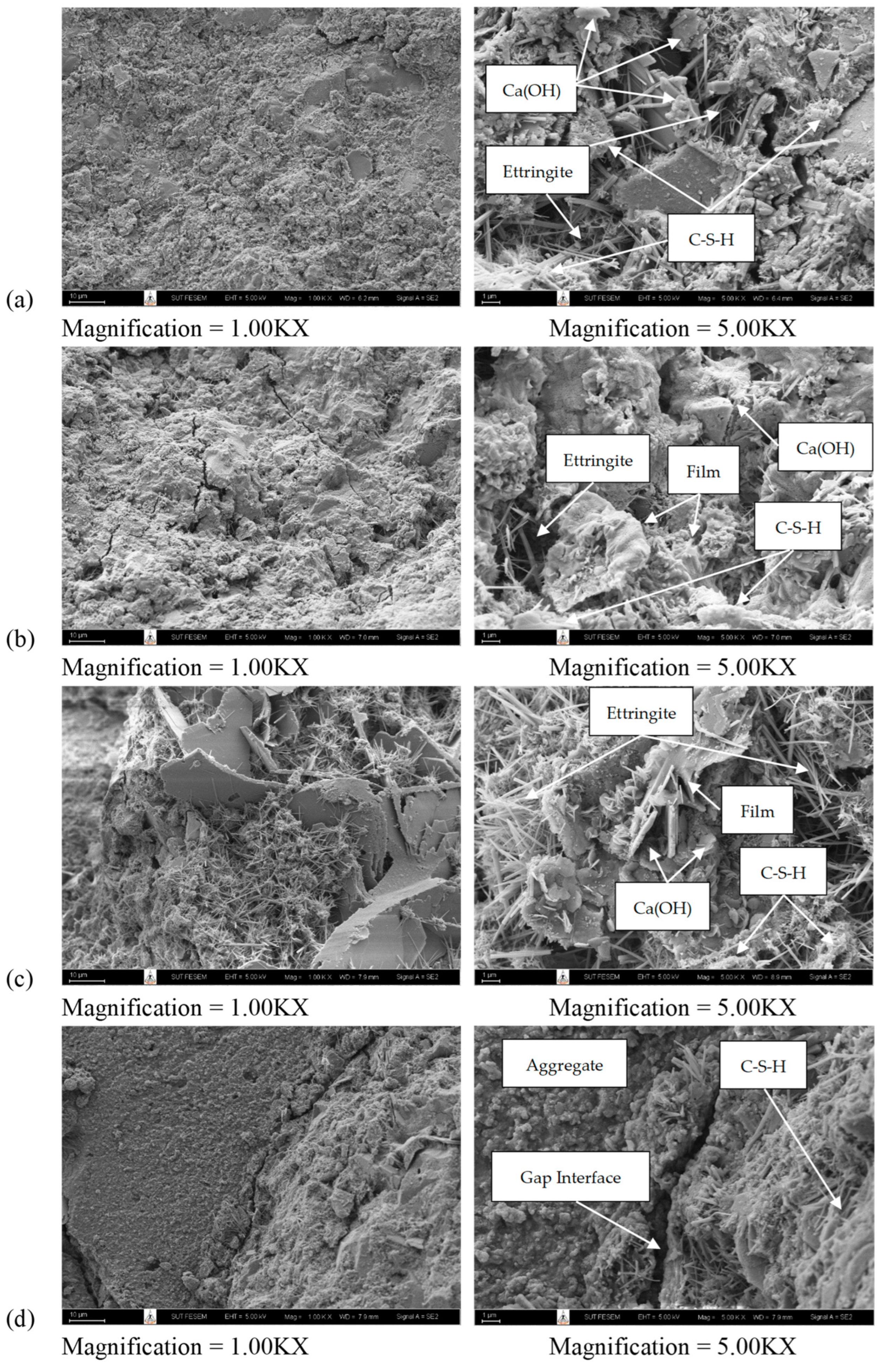
| Properties | Value |
|---|---|
| pH value | 10.4 |
| Dry rubber (%) | 52.0 |
| Water and water-soluble components (%) | 47.3 |
| Ammonia (%) | 0.69 |
| Properties | Value |
|---|---|
| Coarse Aggregate | |
| Maximum size aggregate (mm) | 19.0 |
| Saturated surface dry specific gravity | 2.70 |
| Dry specific gravity | 2.47 |
| Dry rodded density (kg/m3) | 1630 |
| Absorption (%) | 1.85 |
| Moisture content (%) | 1.02 |
| Abrasion loss (%) | 22.2 |
| Flakiness index (%) | 27.7 |
| Elongation Index (%) | 22.4 |
| Fine Aggregate | |
| Saturated surface dry specific gravity | 2.65 |
| Dry specific gravity | 2.60 |
| Percentage of voids (%) | 38.2 |
| Dry unit density (kg/m3) | 1604 |
| Absorption (%) | 0.74 |
| Moisture content (%) | 2.46 |
| Fineness modulus | 2.70 |
| Crumb Rubber | |
| Appearance | Black and Rough |
| Particle size (mm) | 2–3 |
| Dry specific gravity | 1.02 |
| Water absorption (%) | 1.05 |
| Melting point (°C) | 196 |
| PET | |
| Appearance | Round and Smooth |
| Particle size (mm) | 9–10 |
| Specific gravity | 1.20 |
| Water absorption (%) | 0.02 |
| Melting point (°C) | 255 |
| Mix Ingredients | Mix ID | w/c | Cement (kg/m3) | Water (kg/m3) | F.A. (kg/m3) | C.A. (kg/m3) | NRL (kg/m3) | ||
|---|---|---|---|---|---|---|---|---|---|
| Sand | CR | NCA | PET | r/c = 0.58 | |||||
| Normal Concrete | Control | 0.50 | 385 | 192.5 | 745 | 0 | 1052 | 0.0 | 0.00 |
| NRL (r/c = 0.58%) | NRL | 0.50 | 385 | 191.4 | 745 | 0 | 1052 | 0.0 | 2.23 |
| 5% PET + 5% CR + 0.58% NRL | NRL10WP | 0.50 | 385 | 191.4 | 708 | 37 | 999 | 53 | 2.23 |
| 10% PET + 10% CR + 0.58% NRL | NRL20WP | 0.50 | 385 | 191.4 | 671 | 75 | 947 | 105 | 2.23 |
| 15% PET + 15% CR + 0.58% NRL | NRL30WP | 0.50 | 385 | 191.4 | 633 | 112 | 894 | 158 | 2.23 |
| Mix ID | Density Kg/m3 | Modulus of Elasticity GPa | Flexural Toughness MPa·m | Compressive Toughness MJ/m3 |
|---|---|---|---|---|
| Control | 2386.4 | 33.91 | 1.29 | 5.35 |
| NRL | 2385.2 | 24.27 | 1.65 | 4.48 |
| NRL10WP | 2342.3 | 20.37 | 1.81 | 4.74 |
| NRL20WP | 2325.6 | 16.18 | 1.89 | 4.30 |
| NRL30WP | 2305.4 | 13.04 | 2.02 | 4.22 |
Disclaimer/Publisher’s Note: The statements, opinions and data contained in all publications are solely those of the individual author(s) and contributor(s) and not of MDPI and/or the editor(s). MDPI and/or the editor(s) disclaim responsibility for any injury to people or property resulting from any ideas, methods, instructions or products referred to in the content. |
© 2023 by the authors. Licensee MDPI, Basel, Switzerland. This article is an open access article distributed under the terms and conditions of the Creative Commons Attribution (CC BY) license (https://creativecommons.org/licenses/by/4.0/).
Share and Cite
Samingthong, W.; Hoy, M.; Ro, B.; Horpibulsuk, S.; Yosthasaen, T.; Suddeepong, A.; Buritatum, A.; Yaowarat, T.; Arulrajah, A. Natural Rubber Latex-Modified Concrete with PET and Crumb Rubber Aggregate Replacements for Sustainable Rigid Pavements. Sustainability 2023, 15, 14147. https://doi.org/10.3390/su151914147
Samingthong W, Hoy M, Ro B, Horpibulsuk S, Yosthasaen T, Suddeepong A, Buritatum A, Yaowarat T, Arulrajah A. Natural Rubber Latex-Modified Concrete with PET and Crumb Rubber Aggregate Replacements for Sustainable Rigid Pavements. Sustainability. 2023; 15(19):14147. https://doi.org/10.3390/su151914147
Chicago/Turabian StyleSamingthong, Wisanukhorn, Menglim Hoy, Bundam Ro, Suksun Horpibulsuk, Thanongsak Yosthasaen, Apichat Suddeepong, Apinun Buritatum, Teerasak Yaowarat, and Arul Arulrajah. 2023. "Natural Rubber Latex-Modified Concrete with PET and Crumb Rubber Aggregate Replacements for Sustainable Rigid Pavements" Sustainability 15, no. 19: 14147. https://doi.org/10.3390/su151914147
APA StyleSamingthong, W., Hoy, M., Ro, B., Horpibulsuk, S., Yosthasaen, T., Suddeepong, A., Buritatum, A., Yaowarat, T., & Arulrajah, A. (2023). Natural Rubber Latex-Modified Concrete with PET and Crumb Rubber Aggregate Replacements for Sustainable Rigid Pavements. Sustainability, 15(19), 14147. https://doi.org/10.3390/su151914147









